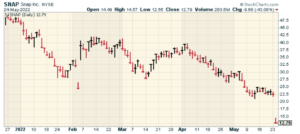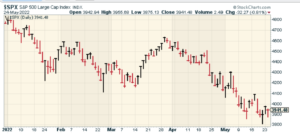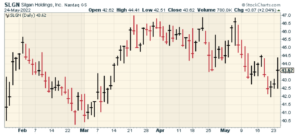CWS Market Review – May 24, 2022
(This is the free version of CWS Market Review. If you like what you see, then please sign up for the premium newsletter for $20 per month or $200 for the whole year. If you sign up today, you can see our two reports, “Your Handy Guide to Stock Orders” and “How Not to Get Screwed on Your Mortgage.”)
Snap, Crackles and Pops
Last week, it was retail. This week, it’s social media. Today was an exceptionally brutal day for social media stocks. Shares of Snap (SNAP) fell over 43%. In a regulatory filing, the owner of Snapchat said, “the macroeconomic environment has deteriorated further and faster than anticipated.”
Hmm. I’m not sure if the problem stems from the macroeconomy or the simple fact that Snapchat isn’t as popular as TikTok.
The Snap news was enough to bring down a few other social media stocks. Shares of Facebook, or more formally, Meta Platforms (FB), fell by 7.6%. The stock still hasn’t recovered from the super-atomic wedgie it got two months ago. Google, formally called Alphabet Inc., (GOOGL) also got caught up in the selling. Shares of GOOGL dropped 5% today. Pinterest (PINS) lost 23%.

During today’s trading, shares of Twitter (TWTR) got as low as $35.40. Elon Musk’s offer price is now more than 50% higher than Twitter’s current share price. I think that’s a clear sign that the Musk deal ain’t gonna happen. You’ve heard of people “voting with their feet.” This is people voting with their sell orders.
I feel as if I’m committing some terrible social faux pas by mentioning something as archaic as actual business metrics, but someone needs to point out that Snap is not very profitable, nor has it been very profitable and it may never make a sustainable profit.
Don’t take my word for it. It literally says that in the company’s prospectus. To wit:
“We have incurred operating losses in the past, expect to incur operating losses in the future, and may never achieve or maintain profitability.”
(Don’t believe me? See this link, page 6.)
I hate to say it, but that line probably turned out to be the most accurate statement ever put out by Snap. To be fair, Snap has had some positive quarters, but nothing impressive. Now they’re saying that things look worse than before. This comes on top of a previous warning last month that inflation and supply-chain issues were weighing on the company’s profitability.
How Long Will the Lousy Market Last?
On Thursday, the S&P 500 closed at a 14-month low. Measured from the highest closing level from January 3, the index lost 18.7%.
The market went even lower during the day on Friday, but thanks to a late-day rally, the S&P 500 closed a tad higher on the day, but going by the intra-day numbers, the S&P 500 had lost 20.9% from its peak.
How much lower can we go?
The true answer is that I have no idea, nor do I much care. But I will lay out a few facts about bear markets.
The most important is that bear markets happen. They always have and always will. Statistically, bears come around about once every four years. That seems about the length of Wall Street’s memory.
The second fact is that bear markets tend to be very short. Even if the peak to trough lasts several months, the worst damage is often concentrated to a few weeks. Sometimes, a few days.

Importantly, bear markets are not felt evenly. Typically, the worst declines strike the sectors that had the biggest gains during the run-up. We’re certainly seeing that now. In fact, the Nasdaq peaked in November, a few weeks before the overall market peaked.
On the whole, our Buy List stocks have held up much better than the rest of the market, and that includes our big losers like Ross Stores (ROST) and Trex (TREX). In most any portfolio, you’re going to have some laggards – that’s why diversification helps.
Bear markets often have several false starts. Don’t get too excited about big one-day rallies. Usually, the bigger they are, the more likely they are to be fakes. I even mentioned that to you in late March after the market had a nice run-up: “I’ve been a doubter of this rally nearly since Day #1. It’s moved too fast, too soon, and it’s been too concentrated in higher-risk stocks.” That turned out to be the day of the market’s near-term peak.
In this case, I was mostly lucky, but be wary of bulls bearing gifts.
Perhaps the best lesson of bear markets is that this is when you see a lot of bargains. You simply have to be patient. I reserve the best ideas for our premium letter, but I will pass along the opportunity in Silgan Holdings (SLGN). This is a company that’s not very well known, which is how I like it.

Silgan is one of the world’s leading makers of metal cans and consumer packaging. The company employs over 15,000 people. Last month, Silgan said it made 78 cents per share for Q1. That was two cents better than estimates. CEO Adam Greenlee said, “Revenues grew significantly in each of our businesses as we successfully passed through raw-material and other cost inflation to the market.”
Business is going so well that Silgan raised its full-year guidance range to $3.90 to $4.05 per share. The previous range was $3.80 to $4.00 per share. In February, the company bumped up its quarterly dividend from 14 to 16 cents per share.
Don’t overlook these quiet stocks. They can be very profitable. The shares have trended lower over the last few weeks. Going by the company’s own guidance, shares of Silgan are going for a little over 10 times this year’s earnings estimate. Plus, the dividend yields about 1.5%.
Shout Out for Medical Devices Stocks
I also wanted to highlight one of my favorite investment sectors. That sector is medical device stocks. This is a great area to find strong investments. Some of my favorites in this field include Abbott Labs (ABT), Stryker (SYK), Edwards Lifesciences (EW), Medtronic (MDT) and Zimmer Biomet (ZBH).
This sector brings together several characteristics that make for promising investments. For one, the healthcare industry is massive. There are continuous innovations. The sector is heavily backed by the government. For established companies, the earnings growth tends to be very stable. That’s an underrated feature of many outstanding stocks.
Here’s a good example. The orange line shows the earnings growth line of Stryker. Note how steady the increases have been:

At this resolution, the numbers are a bit blurry, but you can see the consistency of Stryker’s earnings.
Another good feature about this sector is that it hasn’t done terribly well lately. I always pay attention when good stocks or sectors are lagging.
Here’s a look at the iShares U.S. Medical Devices ETF (IHI):

Again, notice how consistent the price gains have been. You can also see that any break from the long-term trend, as we’re having now, has been a good time to buy.
Some of the fund’s top holdings are Abbott Laboratories (ABT), Thermo Fisher Scientific (TMO), Danaher (DHR), Medtronic (MDT), Intuitive Surgical (ISRG), Edwards Lifesciences (EW), Stryker (SYK), Becton Dickinson (BDX), Boston Scientific (BSX) and IDEXX Labs (IDXX). You can probably tell I’m a fan of this sector because so many of these names have been or are currently on our Buy List.
The stock market will be closed on Monday for Memorial Day. Memorial Day is a fairly new holiday for the NYSE. The first time trading was closed for Memorial Day was in 1971.
The last Memorial Day when the market was open was May 25, 1970. That was in the middle of a nasty bear market, the worst since the great depression. The market bottomed the next day. The Dow has lost 35% in a year.
The losses were even greater than the indexes suggest because they were huge losses in over-the-counter securities. That led to the Nasdaq being founded the following year. If you were ever curious, the Nasdaq Composite started life at 100.00 on February 5, 1971. It’s outlasted several bear markets and so will we.
That’s all for now. I’ll have more for you in the next issue of CWS Market Review.
– Eddy
Posted by Eddy Elfenbein on May 24th, 2022 at 7:51 pm
The information in this blog post represents my own opinions and does not contain a recommendation for any particular security or investment. I or my affiliates may hold positions or other interests in securities mentioned in the Blog, please see my Disclaimer page for my full disclaimer.
-
-
Archives
- April 2025
- March 2025
- February 2025
- January 2025
- December 2024
- November 2024
- October 2024
- September 2024
- August 2024
- July 2024
- June 2024
- May 2024
- April 2024
- March 2024
- February 2024
- January 2024
- December 2023
- November 2023
- October 2023
- September 2023
- August 2023
- July 2023
- June 2023
- May 2023
- April 2023
- March 2023
- February 2023
- January 2023
- December 2022
- November 2022
- October 2022
- September 2022
- August 2022
- July 2022
- June 2022
- May 2022
- April 2022
- March 2022
- February 2022
- January 2022
- December 2021
- November 2021
- October 2021
- September 2021
- August 2021
- July 2021
- June 2021
- May 2021
- April 2021
- March 2021
- February 2021
- January 2021
- December 2020
- November 2020
- October 2020
- September 2020
- August 2020
- July 2020
- June 2020
- May 2020
- April 2020
- March 2020
- February 2020
- January 2020
- December 2019
- November 2019
- October 2019
- September 2019
- August 2019
- July 2019
- June 2019
- May 2019
- April 2019
- March 2019
- February 2019
- January 2019
- December 2018
- November 2018
- October 2018
- September 2018
- August 2018
- July 2018
- June 2018
- May 2018
- April 2018
- March 2018
- February 2018
- January 2018
- December 2017
- November 2017
- October 2017
- September 2017
- August 2017
- July 2017
- June 2017
- May 2017
- April 2017
- March 2017
- February 2017
- January 2017
- December 2016
- November 2016
- October 2016
- September 2016
- August 2016
- July 2016
- June 2016
- May 2016
- April 2016
- March 2016
- February 2016
- January 2016
- December 2015
- November 2015
- October 2015
- September 2015
- August 2015
- July 2015
- June 2015
- May 2015
- April 2015
- March 2015
- February 2015
- January 2015
- December 2014
- November 2014
- October 2014
- September 2014
- August 2014
- July 2014
- June 2014
- May 2014
- April 2014
- March 2014
- February 2014
- January 2014
- December 2013
- November 2013
- October 2013
- September 2013
- August 2013
- July 2013
- June 2013
- May 2013
- April 2013
- March 2013
- February 2013
- January 2013
- December 2012
- November 2012
- October 2012
- September 2012
- August 2012
- July 2012
- June 2012
- May 2012
- April 2012
- March 2012
- February 2012
- January 2012
- December 2011
- November 2011
- October 2011
- September 2011
- August 2011
- July 2011
- June 2011
- May 2011
- April 2011
- March 2011
- February 2011
- January 2011
- December 2010
- November 2010
- October 2010
- September 2010
- August 2010
- July 2010
- June 2010
- May 2010
- April 2010
- March 2010
- February 2010
- January 2010
- December 2009
- November 2009
- October 2009
- September 2009
- August 2009
- July 2009
- June 2009
- May 2009
- April 2009
- March 2009
- February 2009
- January 2009
- December 2008
- November 2008
- October 2008
- September 2008
- August 2008
- July 2008
- June 2008
- May 2008
- April 2008
- March 2008
- February 2008
- January 2008
- December 2007
- November 2007
- October 2007
- September 2007
- August 2007
- July 2007
- June 2007
- May 2007
- April 2007
- March 2007
- February 2007
- January 2007
- December 2006
- November 2006
- October 2006
- September 2006
- August 2006
- July 2006
- June 2006
- May 2006
- April 2006
- March 2006
- February 2006
- January 2006
- December 2005
- November 2005
- October 2005
- September 2005
- August 2005
- July 2005
 Eddy Elfenbein is a Washington, DC-based speaker, portfolio manager and editor of the blog Crossing Wall Street. His
Eddy Elfenbein is a Washington, DC-based speaker, portfolio manager and editor of the blog Crossing Wall Street. His